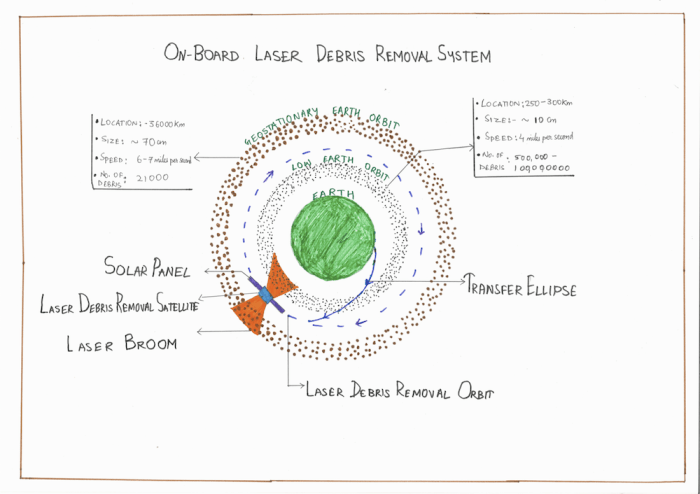Introduction
Today space debris traffic is one of the most critical concerns for space researchers. The current population of space debris is divided into small fragmentation debris of about 42 %, satellite and rocket bodies debris of about 17 % and dead spacecraft debris of about 31 %. Most of the debris are concentrated mainly in Low Earth Orbit (LEO) and Geostationary Earth Orbit (GEO), which imposes a major threat for future space missions due to high risk of collisions with the active spacecraft.
According to Kessler’s syndrome, more and more debris will be produced due to continuous collisions among existing debris even if in future all launches into space are stopped. Therefore, removal of space debris is one of the major concern then repositioning them to higher disposal orbit. There is around 21000 debris of size approximately 70 cm, present in the Geostationary Earth Orbit (GEO) and 500000-100000000 debris of size approximately 10 cm are present in the Low Earth Orbit (LEO). This debris is rotating at an approximate speed of 6-7 miles per hour for GEO and 4 miles per hour for LEO. Removing space debris is the need of the hour to protect existing working equipment and the astronauts who are on aboard International Space Station (ISS).
On-Board Laser Debris Removal System
Numerous debris removal methods have been proposed by several researchers across the globe but On-Board Laser Debris Removal System is more beneficial. This system consists of a laser debris removal satellite which will be placed in an orbit between LEO and GEO. With this system, tiny debris particle can be burned down completely whereas larger debris could be transferred to lower altitude which would ultimately burn down due to severe aerodynamic heating effect.
The proposed laser system will rotate around the earth at 7.5 Km/s and the speed of rotation of laser debris removal system can be modified according to the amount of debris to be removed in that region. This system would have potential advantages like easy to maintain, high average power, peak power, high pulse energy, mature technology, and high laser broom quality. To increase the intensity of laser broom, the power collection at solar cells has to be increased. The entire body of the laser debris removal satellite can be equipped with solar panels in order to increase the amount of power. Laser broom technology can be used to cover a greater laser beam area than a single pointed laser beam.
Unlike other debris removal methods, Laser debris removal system is cost effective and can remove the higher amount of debris. Another advantage is that low power density is required as compared to Ground-based laser debris removal system. In addition to it, no wastage of laser beam and it can totally exterminate the debris instead of relocating them to much higher altitude or disposal orbit. This system can also be equipped with the existing International Space Station which will also reduce the transportation and building cost for the new system.
Voting
-
ABOUT THE ENTRANT
- Name:Umang Singhal
- Type of entry:individual
- Profession:
- Patent status:none

